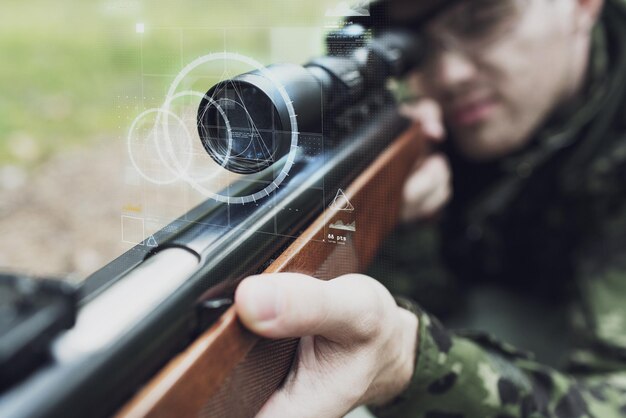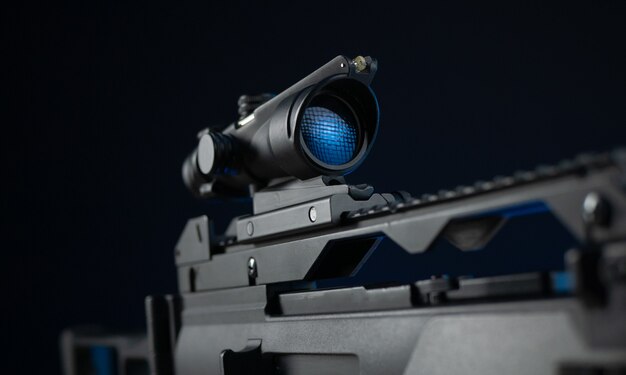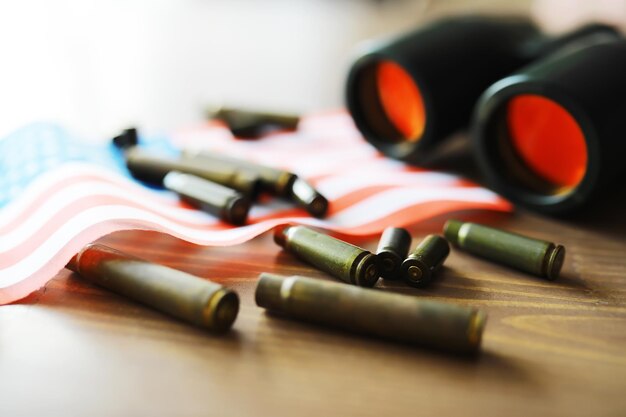How To Choose Optics Of Firearms In The United States?
by Abdul Aziz Mondal Our Blogs Published on: 23 January 2024 Last Updated on: 06 December 2024

The rifle hung there, almost affectionately cradled in the shooter’s hands. It was an extension of the marksman’s will, a convergence of skill and mechanics. But the rifle alone wasn’t complete—not without its optics.
The precision with which a firearm delivers its lethal cargo rests not only on the quality of its barrel or the steadiness of the hand that holds it but also on the clarity and suitability of its optics. In the realm of firearms, gun optics are the eyes through which shooters perceive their target. They shrink vast distances down to comprehensible sights, make dim shadows reveal their secrets, and transform uncertainty into precision.
Choosing the right optics isn’t just about enhancing the firearm—it’s about honoring the shooter’s skills, respecting the craft, and, ultimately, ensuring the bullet finds its mark with deliberate intention.
Why It’s Relevant in the United States?
In the United States, firearms are woven into the cultural and historical fabric of the country. The Second Amendment provides a constitutional foundation for American gun ownership, while the modern era imbues it with contemporary relevance, from personal defense to competitive sports. Within this vast ecosystem of firearms enthusiasts, optics play a critical role.
Hunters scanning the horizon for game, law enforcement officers requiring precision in high-stress scenarios, and competitive shooters striving for accuracy down to the fraction of an inch—all rely on the right optics to excel in their respective fields. Understanding how to choose optics is not a mere hobbyist’s concern; it’s a critical component of responsible gun ownership and operation.
Related: How To Open Online Gun Accessories Store: 5 Tips
Key Factors to Consider When Choosing Optics for Firearms
When selecting the right optics for a firearm, one must navigate a labyrinth of considerations. The intended use—be it hunting, tactical engagement, or sport—leads the way, guiding the discerning eye through factors such as magnification levels, reticle patterns, durability, and light transmission.
The choice encompasses an understanding of the optic’s compatibility with the firearm and the shooter’s ability to harness it in unforgiving conditions. In this discourse, we shall dissect these key factors, providing a compass for those intent on tailoring their armament with precision’s keen edge.
Basics of Optics

1. Definition of Optics and Its Role in Firearms
Optics, in the context of firearms, refers to the devices used to enhance the shooter’s ability to see and accurately engage targets. These feats are accomplished through the manipulation of light and the magnification of images.
With an optic mounted on a firearm, a shooter can adjust for range, compensate for wind, and attain a clearer view of the target than what the naked eye could provide. Optics essentially serve as an extension of the shooter’s vision, imbuing them with a greater degree of control over where each round is placed.
2. Different Types of Optics Available for Firearms
The landscape of firearm optics is as varied as the terrain of the American continent, each offering a unique tool for the job at hand.
Scopes
Or telescopic sights are the quintessential long-distance shooter’s companion. Equipped with magnification, a scope can bring distant targets into a clear, crisp focus, allowing for precise shot placement. Within their ranks, you find a spectrum of magnification power and reticle designs — from the crosshair to the more intricate mil-dot — catering to the vast range of shooting disciplines.
Red dot sights
RDS offer no magnification but compensate with an illuminated “red dot” as an aiming point, making them ideal for situations requiring rapid target acquisition and shooting on the move. They come into their own within close to moderate ranges, where speed outweighs the need for long-range precision.
Holographic sights
It projects an illuminated hologram of a reticle onto a glass pane in the shooter’s line of sight. These devices excel at allowing the shooter to focus on both the reticle and the target simultaneously, promoting an incredibly fast and instinctive aiming method.
Each of these optics has its own strengths and places within a shooter’s arsenal. Choosing correctly is less about finding the most expensive or highest-powered optic and more about finding what augments the shooter’s natural ability, suits their purpose, and becomes an extension of their will. That’s the intricate dance of picking the right optic — a dance that, if mastered, can elevate one’s shooting to an art form.
Factors to Consider
The interplay between a marksman and their optics is a courtship of performance and necessity. An optic must be an extension of both the shooter and their firearm—a trifecta of purpose, compatibility, and precision.
It’s a careful dance of parameters arranged just so, to ensure that when the moment of truth arrives, the union of human, firearm, and optics performs with flawless synchrony.
Let us delve into these considerations that must be appraised with a judicious eye when selecting the optics that will crown one’s firearm.
A. Purpose of the Firearm
In the kinetic world of firearms, purpose dictates form. The brush hunter threading through dense woodlands requires a vastly different optic than the benchrest shooter aiming to punch holes in paper with robotic consistency. For the hunter, a low-magnification rifle scope that provides a wide field of view for a rapidly moving game is often paramount.
In self-defense situations, optics must afford quick, intuitive target acquisition—here, reflex sights shine. Target shooters, conversely, might gravitate toward high magnification scopes that permit exact reticle placement on distant bulls’ eyes. The optic chosen must be congruent with the mission—it is this harmony that defines efficacy.
B. Compatibility with the Firearm
Mount up the wrong firearm optics, and you’ll have a partnership as ill-suited as a square peg in a round hole. The firearm’s architecture lays the foundation for optic compatibility. Rail systems, mounts, and the firearm’s recoil all dictate the suitability of an optic. A heavy, high-powered scope can turn an agile carbine into a cumbersome burden, while a delicate optic can be battered to oblivion by the fierce recoil of a magnum rifle.
Dimensions, too, are crucial. Size and weight affect the firearm’s balance, handling, and portability. The discerning shooter must weigh these factors vigilantly, ensuring that the firearm and optic are allies, not adversaries.
C. Magnification and Reticle Options
Magnification brings the distance near, but it’s a double-edged sword. Higher magnification can reveal a world unseen to the naked eye, but it narrows the field of view and can introduce instability. Matching magnification levels to expected engagement distances is key.
A reticle, meanwhile, is the shooter’s guide—an intersection of lines or a point of light that must align with the quarry. From the minimalist dot to the complex grid of a Mil-Dot reticle, the choice hinges on one’s requirements for range estimation and shot adjustment at varying distances.
D. Durability and Reliability
When the tempest rages, and the elements conspire, optics must stand as unfaltering beacons of resilience. Waterproofing and fogproofing are not extravagances but necessities. Lens coatings that repel the harsh glare of the sun, and rugged construction to withstand shock and vibration—these are the bulwarks against failure. Optics must be the dependable constants in a universe of variables.
E. Budget Considerations
The financial aspect cannot be afforded the luxury of oblivion. Optics span the spectrum from the economical to the exorbitant. Prudence dictates finding a balance between desired features and fiscal constraints. The most astute choice is the optic for a gun that fulfills the role without leaving the wallet hollow—a device that punches above its cost yet humbly acknowledges its price point.
In the crucible that is optics selection for firearms, each consideration becomes a thread in a tapestry of decision-making. Purpose and compatibility guide the hand; magnification and reticle preferences refine the design; durability ensures the piece withstands time, and budget ensures it does not become an artifact of regret. It is in the confluence of these factors that the ideal optic is forged for the keeper of the firearm.
Legal Considerations in the United States

Navigating the labyrinthine rules of firearm optics legislation is akin to sighting downrange through a reticle clouded by a morning mist—a clear view is imperative but not always easily achieved.
In the United States, where the right to bear arms is enshrined in the Constitution, regulations still temper the sea of liberty, ensuring that the waves do not crash too wildly. Legalities surrounding firearm optics are no less immune to these currents, and a marksman must be as deft in understanding these requirements as they are in hitting a distant target.
Relevant Laws and Regulations Regarding Optics for Firearms
In the broad landscape of American firearms legislation, the topic of optics is, by and large, a relatively less regulated expanse. However, it is not without its signposts and barriers. Federal law primarily concerns itself with the overall legality of the firearm, whereas optics remain, in many ways, ancillary. Yet, there are crucial caveats.
For instance, the National Firearms Act (NFA) has stipulations regarding certain devices that could convert a firearm into what might be categorized as a Short Barrel Rifle (SBR), which in turn would subject the device and firearm to a higher tier of regulatory scrutiny.
Additionally, optics, like one from Lead and Steel, that employ night vision or thermal imaging technologies intersect with more stringent guidelines. These advanced sighting systems may require registration and are subject to export restrictions under the International Traffic in Arms Regulations (ITAR). Distributors and owners alike must tread carefully here to ensure adherence to the intricate dance of compliance.
Restrictions or Requirements for Certain Types of Optics
Transitioning focus to specific articles in this legislative canon, certain restrictions surge forth. It is not the common rifle scope that bears the weight of these prohibitions, but rather those optics that enable visibility where the human eye falters—in darkness.
Night vision scopes and thermal imaging optics stand under a microscope of regulation. Civilians are generally permitted to use and own these technologies, yet some states impose their own set of rules that either limit or outright ban the use of such optics for hunting.
Additionally, if an optic, regardless of its nature, is to be mounted to a firearm regulated under the NFA, then the combined system must conform to the law. This could involve registration, tax stamps, and strict adherence to guidelines that dictate possession and transportation. The conspectus is clear: certain optics elevate the level of attention a firearm receives from the watchful eyes of the law.
Tips for Ensuring Compliance with Local and Federal Laws
To ensure that one’s optics choices don’t stray beyond the bounds of legality, the following counsel is proffered. First, it behooves the owner to engage in robust research or seek legal advice when venturing into the territories of night vision or thermal optics—knowledge, here more than ever, is the shield against inadvertent transgression.
Second, be acutely aware of the unique requirements of your state and locality. Laws vary like the topography of the American landscape, and one must be as familiar with the local legal environment as they are with their shooting grounds.
Third, when in doubt, reach out. Contact the Bureau of Alcohol, Tobacco, Firearms and Explosives (ATF), or a legal expert with experience in firearms law. These sentinels can guide one through the fog and toward the clear vista of compliance.
And lastly, if engaging in the sale, transfer, or transportation of optics across state lines—especially those of the advanced variety—it is prudent to consult with ITAR and the ATF to ensure all is aligned with the rigors of regulation.
The tapestry of American gun laws is an intricate weave, replete with nuance and regional pattern. The discerning firearm owner, keen to stay aligned with the letter of the law, must possess an eagle eye for these details when choosing their optics. This diligence ensures that their sights are set, steady, and within the clear bounds of the law.
Final Shot
In the endgame of equipping a firearm with the proper optics, the considerations laid out remain steadfast, like a fixed stock against a marksman’s shoulder.
Key factors such as the firearm’s purpose, its symbiosis with the chosen optic, the rigor of magnification needs and reticle functionalities, the unyielding demand for durability, and the constraints of a budget—all converge to guide the decision-making process.
One must not only understand the technicalities but align them with intent and legality, ensuring the optic is a true enhancement to the firearm’s appointed role.
Choosing optics is not a task to be taken lightly or done in haste—it’s akin to selecting a steadfast companion for every journey to the range or field. The gravity of making an informed decision resonates with the clarity of a bell on a crisp morning. It’s about respecting the equilibrium between technology and skill, and acknowledging that the right choice elevates the capability of both shooter and firearm.
In the fabric of American shooting culture, where the right to bear arms is as intrinsic as the right to free speech, selecting the right optics is more than a simple purchase—it is a testament to the shooter’s right to mastery. Whether for sport, defense, or the hunt, the optics one chooses are a symbol of commitment to precision, safety, and personal responsibility.
On the web of considerations that encompass purpose, compatibility, legal compliance and informed selections, lies the true essence of excellence in marksmanship. It is within this crucible that champions are forged and legacies are built. Remember, when the moment arrives to take that critical shot, it’s the wisdom behind the optics choice that will reveal its true measure.
Read Also:



































































































